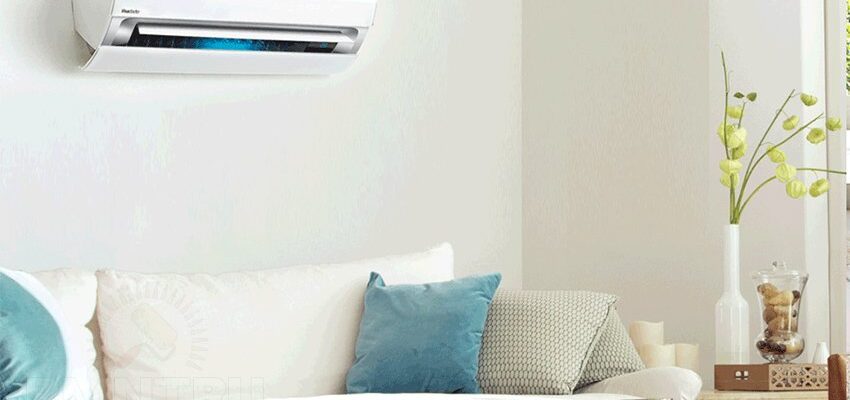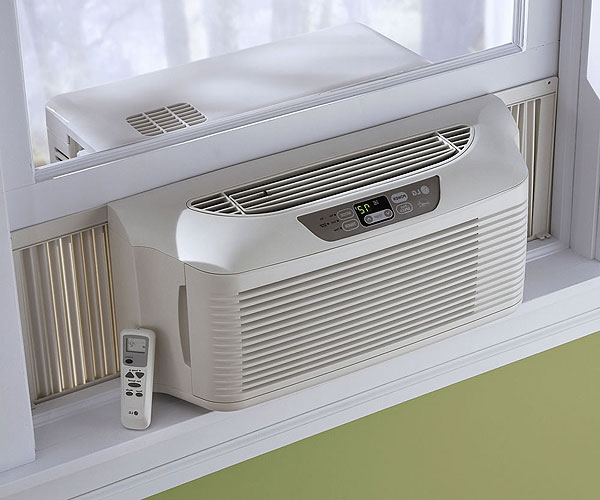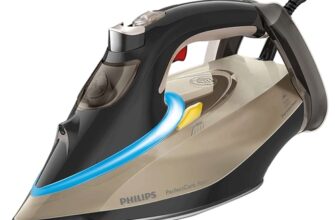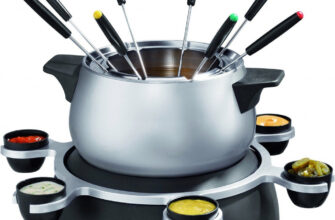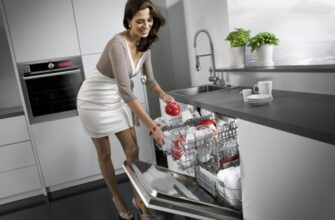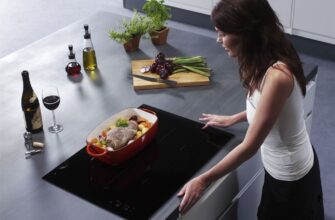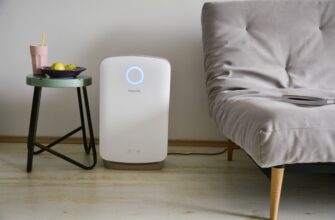When choosing an air conditioner, the main thing is to determine the volume of the room where you plan to use this technique. But other parameters are also important.
- How to choose an air conditioner for an apartment and a house: what to look for
- Types of air conditioners
- Window air conditioners
- Advantages
- disadvantages
- Floor air conditioners
- Advantages
- disadvantages
- Wall split systems
- Advantages
- disadvantages
- Duct air conditioners
- Advantages
- disadvantages
- Which air conditioner to choose
- The main criteria for choosing an air conditioner
- Air conditioner performance
- Nominal air volume
- Air conditioner power consumption
- Noise level
- Operating modes
- Additional features of the air conditioner
- Dehumidification mode
- Ventilation mode
- Air purification mode
- Air ionization mode
- Airflow Direction Adjustment
- Work timer
- Air conditioners with the ability to set a timer
- Advantages
- disadvantages
- Remote control from a smartphone
- Air conditioners cost
- The best air conditioner manufacturers – which company to choose
- Video on choosing an air conditioner for home and office
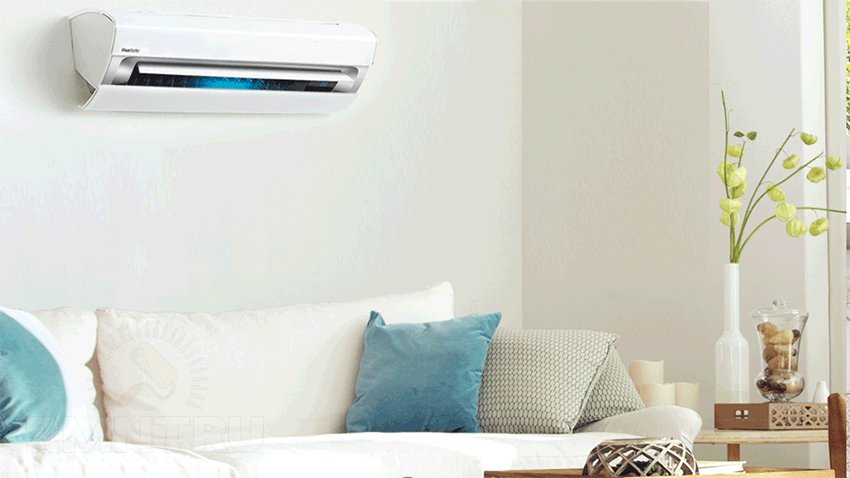
!
We recommend that you familiarize yourself with the rating of the best mobile air conditioners for the home.
How to choose an air conditioner for an apartment and a house: what to look for
When choosing an air conditioner for an apartment, house or office, it is recommended to pay attention to the following parameters:
-
Air conditioner type;
-
Power (including the amount of air in the room that the unit is capable of conditioning);
-
Available operating modes;
-
Noise level;
-
Power consumption level;
-
Additional functionality (dehumidification, ventilation, etc.).
The manufacturer of the air conditioner is also important.
Types of air conditioners
Structurally, according to the principle of operation and the method of installation, air conditioners are divided into the following types:
-
Window;
-
Outdoor;
-
Wall split systems;
-
Duct.
Window air conditioners
Window air conditioners are one of the easiest options both to install and to function. As the name implies, they are mounted directly into the window opening. When turned on, they pump air from the street, while simultaneously heating or cooling it.
The design of such air conditioners includes a single unit in which all functional elements are installed: a compressor, a refrigerator, etc.
Like most other air conditioners of the middle or budget class (and window air conditioners belong to it), they can work to cool or heat the room, and the additional functionality is determined by the type of filter installed. These components can be coal with a high degree of purification, antibacterial with a disinfecting effect, washable, reusable, etc.
Advantages
-
Easy to install. Installation can be carried out even on your own with certain skills and compatible window frames;
-
Easy to operate. Service procedures such as filter replacement or cleaning can be done by yourself;
-
Long operational period. With proper care, a window air conditioner can last for several decades;
-
Low price. Often much lower than other types of air conditioners;
disadvantages
-
High noise level. Since the compressor is essentially in the indoor unit, its operation is very audible;
-
Impossibility or very high complexity of the organization of moisture removal. The condensed water from the air conditioner drips directly from the outlet on the outside. Because of this, it can be very difficult to organize its removal.
-
Violation of the integrity of the window opening. Often, the air conditioner is located loosely in the frame, without adhering to the walls. This leads to the fact that in the cold season, low temperature from the street penetrates the room;
-
The air conditioner occupies the usable area of the window opening. This leads to a decrease in the amount of light entering the room;
!
All this makes a window air conditioner a good option exclusively for places with mild winters.
Floor air conditioners
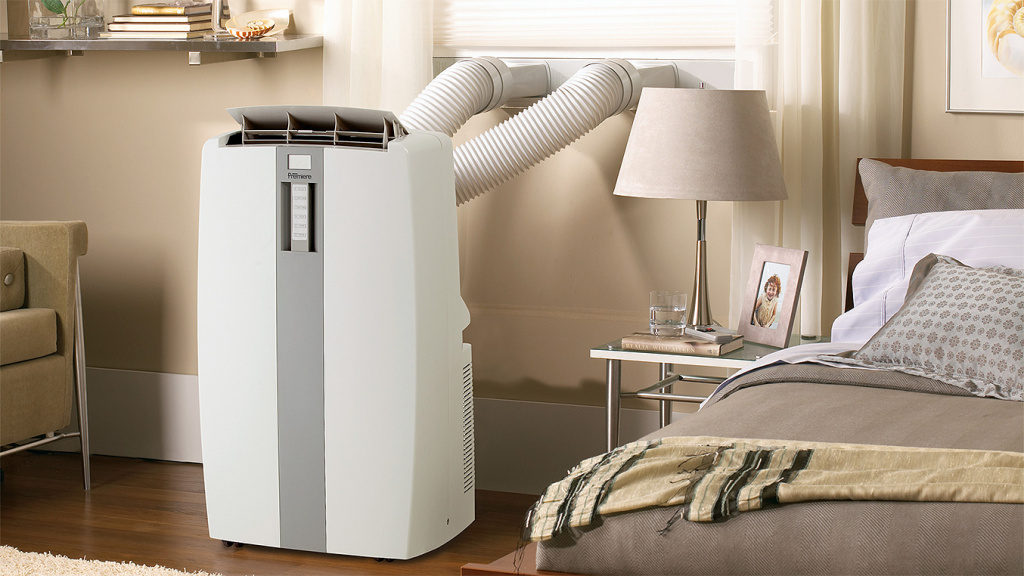
Floor standing air conditioners are of two types – with and without duct. Structurally, they are a mobile unit, in which, by analogy with a window unit, a compressor, refrigerator, filter and other functional units are built.
The air duct is a system of channels in the walls of the room. Through them, hot air is removed from the air conditioner and 'thrown out' into the street. This is the main disadvantage of such devices – the hot air exhaust system must be installed even at the stage of construction or decoration of the premises.
An alternative is to install an air duct in the window opening. Then the tubing is not required.
Floor-standing air conditioners without an air duct, in fact, are not air conditioners. These are rather air humidifiers that additionally heat the room. Because of their action, it may subjectively seem that the room has become cooler, but objectively the temperature does not decrease. In addition, excessive humidification of the air can cause an unpleasant sensation in people suffering from diseases of the cardiovascular or respiratory system.
Some models of floor-standing air conditioners without an air duct still cool the air by passing it through the ice briquettes. But this also leads to increased indoor humidity.
Therefore, when using floor-standing air conditioners, it is better to choose models with an air duct.
Advantages
-
Mobility. They are placed only in the room that needs to be cooled;
-
Ease of installation of the air duct in the window opening (if the pipe system is not used in the room);
-
Easy replacement possible. In the event of a breakdown, it is enough to purchase only a new mobile unit, the air exhaust system does not need to be repaired (unless it becomes clogged);
-
Lack of cold air flowing through the upper area of the room. This protects against blowing and diseases caused by it. Air convection occurs naturally;
disadvantages
-
Low productivity. It takes some time to cool the indoor air;
-
The need to organize an air duct – either in the form of a pipe system or in a part of the window;
-
The need for manual condensate removal. Periodically, the container with it needs to be cleaned – and the more often the better, since bacteria can develop in a humid environment;
-
Large dimensions of the main unit. It is similar in size to a bedside table;
-
High noise level. Similar to window air conditioners, the compressor – the 'loudest' part of the unit – is located in the indoor unit;
-
Pumping out part of the air from the room. It is especially critical for rooms where fresh air does not come for one reason or another;
!
Floor-standing (mobile) air conditioners are only an alternative for full-fledged split systems, but not full-featured devices for room cooling.
Wall split systems
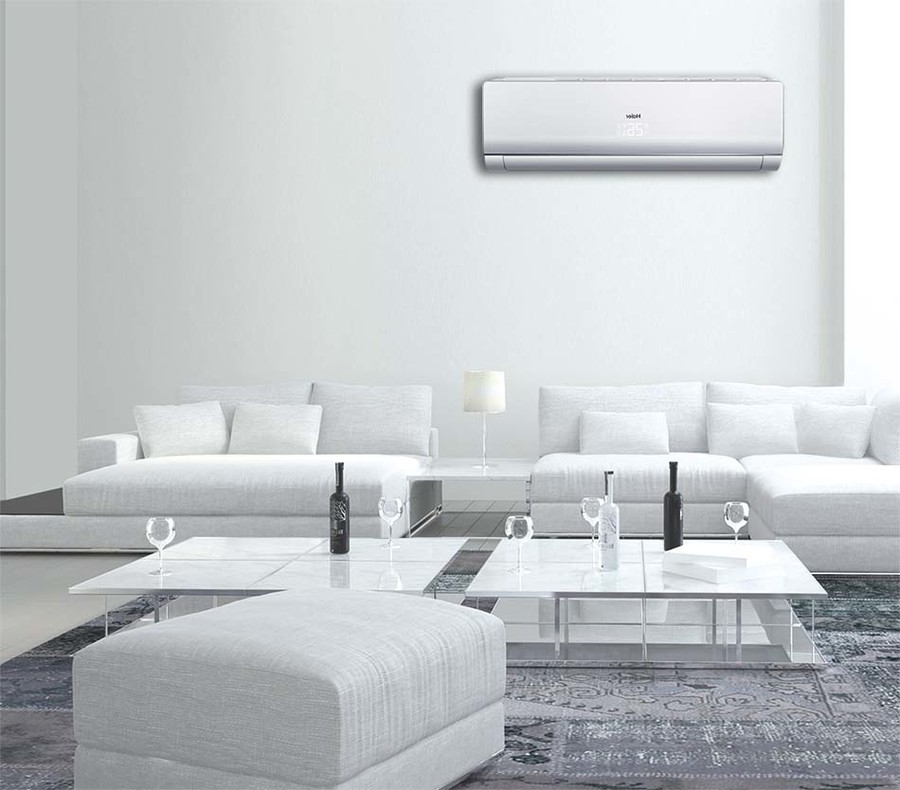
The split system, as the name implies (split in translation from English – 'split'), consists of two blocks. The main unit of the air conditioner, in which the refrigerator is installed, is located on the outer wall of the house. An additional one, with a compressor, is located directly in the room and is designed to remove cooled or heated air.
Split system modules are connected with one or several pipes through which hot air is removed or cold air is pumped in. These channels are laid through the wall, as a result of which the installation of the air conditioner becomes a rather difficult task, and in some cases it also requires permission from the management company (if the ownership rights to the facade of the house are issued to it, for example).
Nevertheless, split systems are the most productive and functional type of air conditioners. They not only quickly cool the room, but are also able to heat it up. And some models also have modes for controlling humidity and air purity.
Advantages
-
Highest performance for fast room temperature control;
-
Optimal price (models that are designed exclusively for cooling can cost about several thousand rubles. At the same time, multifunctional devices are expensive);
-
Advanced functionality;
-
Minimum noise level;
disadvantages
-
Complex, and in some cases problematic installation of the external unit;
-
The need for periodic qualified maintenance, including cleaning and repairing the cooling system.
-
Lack of mobility – the indoor unit cools or heats up only the room in which it is installed;
-
Increased power consumption;
-
The need to break through the wall for laying pipes and cables;
!
Despite the above disadvantages, wall split systems are the best solution for effective protection against high temperatures outside.
Duct air conditioners
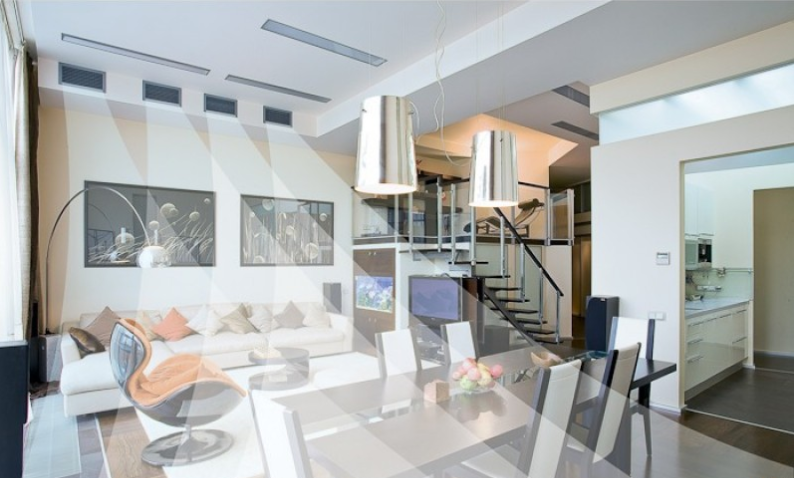
Duct air conditioners are functionally a kind of split systems. The key difference is that a duct system is connected to the indoor unit of such a device. It is through them that cooled air is carried throughout the premises – several rooms, offices, etc.
Since duct air conditioners involve the use of a duct system, their installation should be designed even at the stage of construction or overhaul of a house or apartment. Tubes with outlets can be placed in walls, under false ceilings or in special niches.
The main advantages of such an air conditioner are the absence of a noticeable indoor unit and the possibility of cooling (or heating) several rooms at once. And the disadvantage is the highest complexity of installation – it is required to allocate a separate room for the placement of functional elements and lay air ducts.
Duct air conditioners are usually designed for use in large buildings with high traffic – office centers, restaurants, hotels – therefore, in most cases, they have high power.
Advantages
-
The ability to cool and supply fresh air to several rooms at once;
-
Low cost when used in large office centers, houses, other large premises with many rooms;
-
High performance;
-
Lack of indoor units in refrigerated rooms;
disadvantages
-
Impossibility or high complexity of microclimate regulation in separate rooms;
-
High power consumption;
-
The need for regular professional maintenance, including cleaning the channels;
-
High cost, making it impractical when used in apartments or private houses;
-
High complexity of installation, as a result of which the placement of a duct air conditioner must be planned even before repair;
!
All this makes duct air conditioners an appropriate solution only for use in large buildings with a large number of rooms.
Which air conditioner to choose
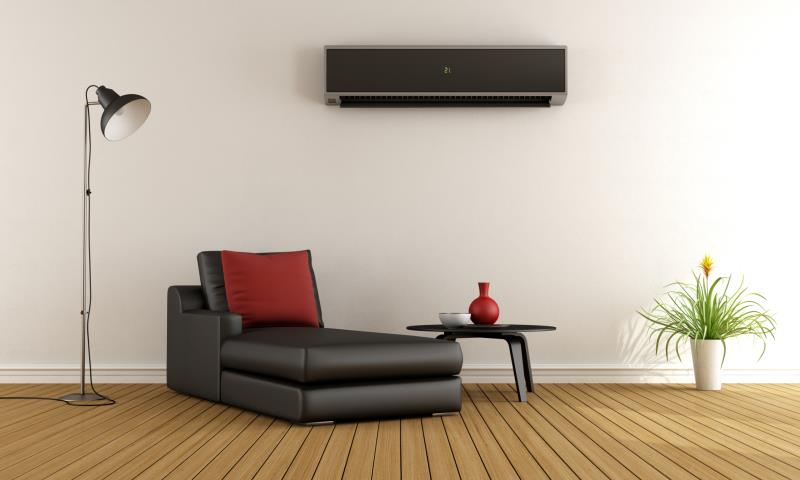
When choosing an air conditioner, it is worth starting from the planned conditions of use and the features of the structure in which it will be installed.
-
If the main requirement for an air conditioner is ease of installation, then you can use window models or floor models with an air duct that throws hot air directly into the window.
-
If the house already has a duct system, a mobile floor air conditioner that connects to the existing ducts is a good solution.
-
If the main requirement is performance and wide functionality, a full-fledged split system will be the ideal solution. It is she who will quickly cool or heat the air in the room. In addition, many models of modern split systems require minimal intervention in the structure of the wall.
-
If you plan to install a single air conditioner in a large private or apartment building, office building or similar structure, a ducted air conditioner will be a good solution.
The main criteria for choosing an air conditioner
When choosing an air conditioner, the following parameters should be considered:
-
Performance (in terms of power or volume for which the air conditioner is designed);
-
Power consumption level;
-
Noise level;
-
Operating modes;
-
Extra options.
Air conditioner performance
The performance of an air conditioner is a parameter that determines at what speed or efficiency the device can cool or heat the air in the room. It is influenced by two characteristics – directly the power of the device and the volume of air for which it is designed.
The power of the air conditioner is measured in watts. The higher it is, the faster the device cools (or heats) the air in the room. But at the same time, energy consumption and the noise level of the air conditioner increase, which is especially critical for window or floor models.
Technically, the power of an air conditioner is a rather vague concept, since manufacturers often indicate not the direct power of the compressor, but the power of the cooling system. It is much higher than consumed. So, in an air conditioner with a cooling system with a capacity of 4 kW, most likely, a 1.3 kW compressor is installed and the actual consumption is also 1.3 kW (or a little more for the operation of other functional elements).
For home use, it is worth choosing air conditioners with a cooling system capacity of up to 4 kW inclusive (up to 1.3 kW of compressor consumption, respectively). Such devices can be connected to a household network without changing it or outputting an additional load channel. It is advisable to include more powerful air conditioners in a separate line to protect the power supply to the rest of the house.
Nominal air volume
The nominal air volume is a more practical parameter for assessing the capacity of an air conditioner. It shows how much (in cubic meters) of air the device can cool or heat under optimal load. It is calculated as follows – you need to take the area of the room or adjacent rooms where you plan to install the air conditioner, and multiply by the height of the ceilings.
When using the air conditioner in rooms whose volume is larger than the rated volume for which the device is designed, it will operate with an increased load, which can lead, at best, to ineffective cooling (heating), and at worst, to damage to the compressor or refrigerator.
Therefore, choosing an air conditioner is primarily based on the volume of the room.
Air conditioner power consumption
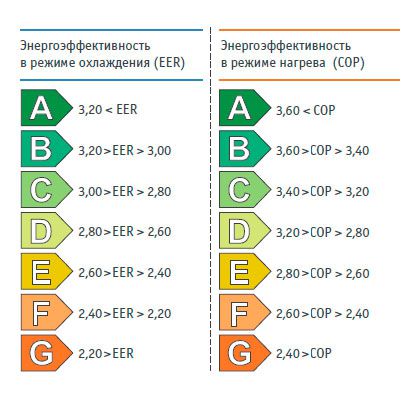
The energy consumption of an air conditioner directly depends on the actual capacity of its compressor and is usually about 110-120% of its value. For heat pump models, this value can be even higher.
It is recommended to purchase inverter air conditioners to reduce energy consumption. These are devices with automatic regulation of the intensity of the compressor. Inverter air conditioners consume most of the electricity at the start (immediately after switching on or changing the set temperature), and later become very economical, since they do not require constant operation of the compressor to maintain the selected microclimatic conditions.
The energy efficiency indicators of air conditioners are EER and COP parameters. The first shows the ratio of the power of the cooling system to the actual power consumption; the second is the ratio of the power of the heating system to the actual power consumption. Both of these parameters have a letter designation scale, in which letter A shows the highest energy efficiency, and letter G – the lowest. It is self-evident that it is worth purchasing air conditioners whose EER and COP parameters are in the A-C range.
Noise level
The noise level depends on two parameters – the power of the air conditioner (the higher it is, the louder the equipment works) and the location of its 'external unit' with a compressor. So, in window and floor devices, the compressor is located in the indoor unit, and therefore, during operation, they emit rather loud sounds. Split systems and duct air conditioners are equipped with a full-fledged external unit and therefore have a low or even zero noise level.
The overwhelming majority of household air conditioners with a cooling system capacity of up to 3 kW have an external unit noise level of up to 55 dB – this corresponds to the loudness of ordinary human speech. In addition, such a loudness is allowed by sanitary standards, including European and Russian ones, for the nighttime.
The lower the noise level, the better. Especially for the indoor unit of the split system. Its noise level for comfortable use should not exceed 20-30 dB, otherwise physical problems may occur (up to the appearance of headaches).
It is clear that table and window air conditioners have a higher noise level – up to 40-50 dB. Therefore, 'loud' devices should be used periodically, just to cool the room, and turned off at night.
Operating modes
Modes of operation in general approximation are of two types – air cooling and heating. And if air conditioners of all models can lower the air temperature in the room, then only some can raise it. This is due to design differences.
If in cooling air conditioners only a refrigerator is used to create a microclimate, then in heating air conditioners they also use a heating element (tubular electric heater) and a heat pump. All of them are designed to increase the air temperature and, depending on the design, can be located both in the external and in the internal unit.
Air heating mode is an optional function for air conditioners or split systems. Therefore, if only cooling is required from such a device, then you can get by with models that are not equipped with heating elements.
Additional features of the air conditioner
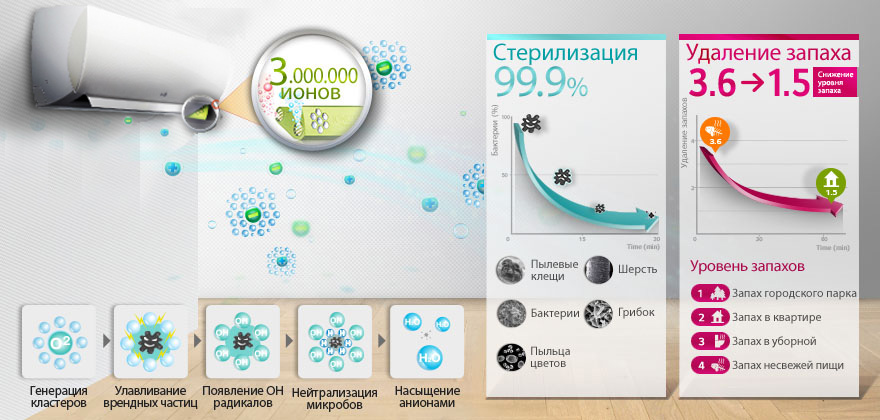
In addition to cooling and heating the air, some models of air conditioners are equipped with additional functionality. These opportunities may include:
-
Dehumidification of air;
-
Ventilation mode;
-
Air cleaning;
-
Air ionization;
-
Air flow direction adjustment;
-
Work timer;
-
Smartphone remote control and smart functions.
Dehumidification mode
Dehumidification of indoor air allows you to make the microclimate more comfortable and environmentally friendly – in an environment of low humidity, pathogenic bacteria develop more slowly. Almost all air conditioners and split systems also reduce air humidity during normal operation (cooling mode). However, some models are equipped with a dehumidification function without cooling, which can be used in autumn and winter.
Dehumidification mode is a useful feature, but only if you really need it. That is, it is regularly required to reduce the level of humidity – for example, in the bedroom, especially if it comes into contact with the bathroom or toilet.
Ventilation mode
The ventilation mode is designed to create an inflow of fresh air from the street without cooling or heating it. If you plan to install the air conditioner in a room without opening windows, it is highly recommended that it be equipped with this function. In addition, it will be useful during the cold season, when natural ventilation can cause discomfort.
Air purification mode
The air purification mode is similar to the ventilation mode, but in this case the air conditioner drives the air that is present in the room through the system of built-in filters. This reduces the level of dust and other contaminants.
The usefulness of the air purification mode is directly influenced by the filters installed in the air conditioner and their 'freshness'. So, with a factory filter system, only mechanical impurities such as dust are removed from the atmosphere. The charcoal filter also cleans at a chemical level, and the antibacterial filter disinfects.
In very rare models of air conditioners, air purification is carried out by processing it with ultraviolet radiation. This does not remove mechanical suspended matter, but it effectively disinfects the atmosphere.
If the air conditioner is equipped with a cleaning mode, then it is very important to regularly change the filters and rinse the container for storing condensed moisture.
Air ionization mode
The air ionization mode is similar to the cleaning mode, but in this case it is enriched with ions by passing it through a carbon filter or a special ionizer. Thanks to this, the air becomes noticeably fresher (up to the feeling of 'mountain'), and also cleared of pathogens.
Air conditioners with air ionization mode should be used in homes where there are elderly people, children and people with reduced immunity. In addition, they can be used simply to improve the microclimate. This is especially important in urban environments where ventilation through windows can only impair the organoleptic quality of the air.
Airflow Direction Adjustment
Adjustment of the air flow direction is carried out through a movable divider, which is located in the air conditioner outlet. Almost all modern split systems are equipped with this function. The directional control mode allows you to either quickly cool the air in the room thanks to artificial convection, or to get rid of draft and the risk of 'blowing', which is especially important if the air conditioner is located in the immediate vicinity of a work or sleeping place.
Work timer
The operation timer allows you to automate the shutdown of the air conditioner. It can be implemented in two ways. The first and most popular is the automatic shutdown of the air conditioner after a certain time set by the user. The second option is to stop cooling or heating when the set temperature is reached.
Both of these options have both advantages and disadvantages.
Air conditioners with the ability to set a timer
Advantages
-
There is no risk of forgetting the air conditioner turned on and thereby overcooling or overheating the room;
-
The risk of compressor wear and refrigerant leakage is reduced;
-
You can set the air conditioner on a timer and go to bed – after a while it will turn off and stop cooling the room;
-
Energy consumption can be significantly reduced;
disadvantages
-
The air conditioner can turn off before a comfortable or just a suitable microclimate is established in the room;
-
It is required to constantly re-adjust the timer, setting the time or temperature of operation.
!
Thus, the timer is a useful function, but only if the disadvantages are not critical.
Remote control from a smartphone
Smartphone remote control and other 'smart' functions are mostly found in the most modern air conditioners. This is actually not that convenient, since in most cases both devices need to be on the same wireless network. Therefore, the adjustment of the air conditioner can be carried out only in the house – and the smartphone in this case is only a replacement for the remote control.
Nevertheless, various 'smart' functions allow you to set the temperature and operating mode in detail, as well as the on timer – so that the air conditioner refreshes the air in the room when the owner arrives.
'Smart' functions simply make the use of the air conditioner more convenient and do not determine its capabilities, so purchasing climate control devices with a similar control mode is optional.
Air conditioners cost

The cost of air conditioners is determined not only by their type, but also by functionality, as well as power and other operating parameters. Also, offline retailers can further increase the price of the device by adding installation or maintenance services.
-
The price for window air conditioners starts from 8-10 thousand rubles. However, the vast majority of models are in the price range of 20-30 thousand rubles.
-
The price for floor-standing air conditioners with an air duct starts from 10-12 thousand rubles. Similar to window models, the vast majority of models are in the price range of 20-30 thousand rubles.
-
The price for split systems starts from several thousand rubles. The overwhelming majority of models are in the price range of 15-35 thousand rubles, the cost directly depends on power, performance and other technical characteristics.
-
The price for duct air conditioners without installation of a duct system starts from 30-40 thousand rubles, but the vast majority of models are in the price range of 100-150 thousand rubles. The cost directly depends on the power of the device.
The best air conditioner manufacturers – which company to choose
Among the manufacturers of air conditioners, there are companies whose products are distinguished by maximum reliability:
-
Daikin, Mitsubishi, Toshiba, Fujitsu are already well-established Japanese companies producing climatic technology. Air conditioners from these brands differ in a fairly average price, but it is fully justified by the quality and performance of the devices;
-
Haier, Ballu are Chinese air conditioner manufacturers. Their climatic technology is distinguished by a relatively low price and at the same time very high practicality and durability;
-
LG, Samsung – Korean manufacturers. Their equipment is most often equipped with the most modern technological solutions, but belongs to the middle or top price range.
-
In addition, Hitachi is worth highlighting. Her technique is usually expensive, but very high quality.
!
In the following articles, we will tell you how to choose the right humidifier for your home and the secrets of choosing an ionizer for a healthy climate in your apartment.
Video on choosing an air conditioner for home and office
Attention! This material is the subjective opinion of the authors of the project and is not a purchase guide.

